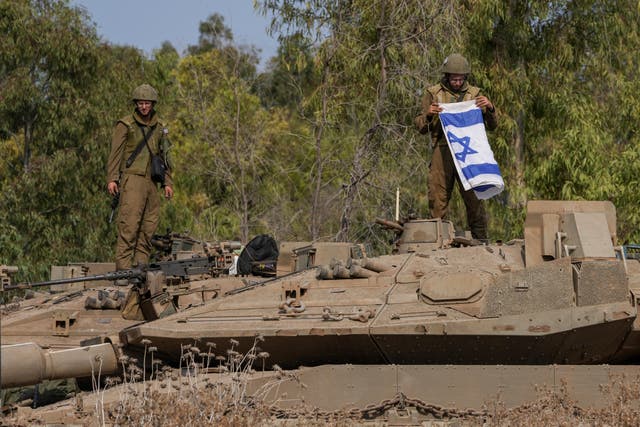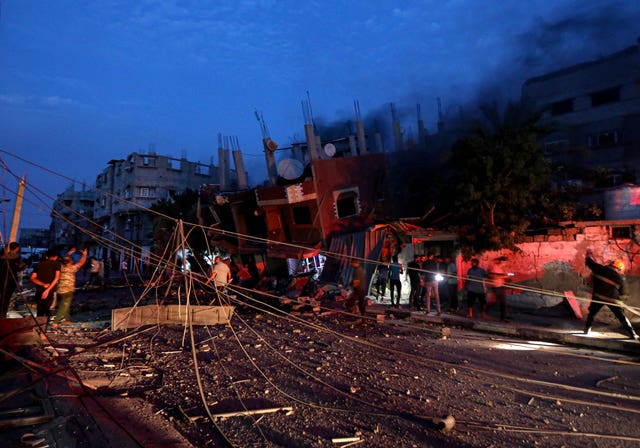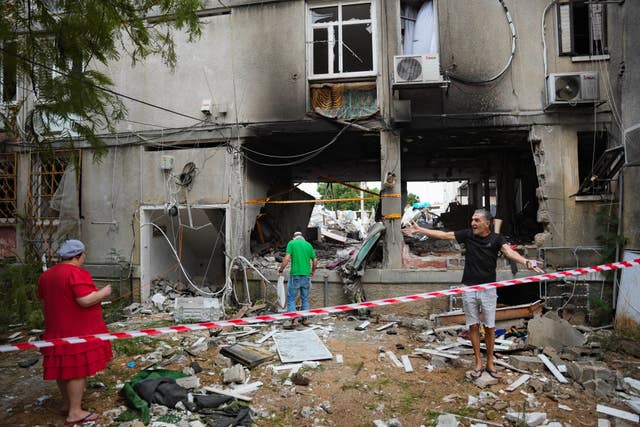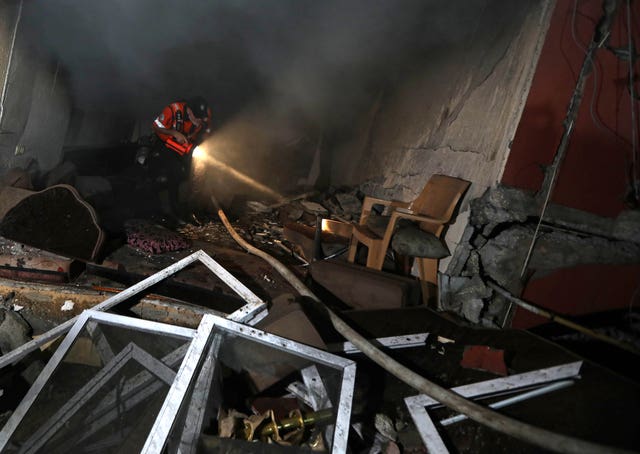Israel’s military ordered a complete siege on the Gaza Strip on Monday, halting entry of food, fuel and supplies to its 2.3 million people as it pounded the Hamas-ruled territory with waves of air strikes in retaliation for the militants’ bloody weekend incursion.
More than two days after Hamas launched its surprise attack from Gaza, the Israeli military said it had largely gained control in its southern towns where it had been battling Hamas gunmen.
Israel’s military and intelligence apparatus was caught completely off guard, resulting in heavy battles in its streets for the first time in decades.

Tanks and drones were deployed to guard breaches in the border fence to prevent new incursions.
Thousands of Israelis were evacuated from more than a dozen towns near Gaza, and the military summoned 300,000 reservists – a massive mobilisation in a short time.
The moves, along with Israel’s formal declaration of war on Sunday, pointed to Israel increasingly shifting to the offensive against Hamas, threatening greater destruction in the densely populated, impoverished Gaza Strip.
On Sunday, strikes flattened much of the Gaza town of Beit Hanoun, which Israel said Hamas was using as a staging ground.
On Monday, the Israeli military blared messages to residents to evacuate Rimal, a residential and commercial district of central Gaza City where offices of the Associated Press and other international media are located, a signal that heavy strikes were to come.
A major question remains whether it will launch a ground assault into the tiny Mediterranean coastal territory, a move that in the past has brought intensified casualties.

Prime Minister Benjamin Netanyahu has vowed to destroy “the military and governing capabilities” of the militant group.
As Israel hit more than 1,000 targets in Gaza, Palestinian militants continued firing barrages of rockets, setting off air raid sirens in Jerusalem and Tel Aviv.
Video posted online appeared to show a plume of smoke near a terminal at Ben Gurion International Airport.
There was no immediate word on casualties or damage from the latest bombardment.

Civilians have already paid a high price.
Around 700 people, including 73 soldiers, have been killed in Israel, according to Israeli media outlets, citing rescue service – a staggering toll by the scale of its recent conflicts.
The Gaza Health Ministry said 493 people, including 78 children and 41 women, were killed in the territory.
Thousands have been wounded on both sides.
Palestinian militant groups claimed to be holding more than 130 people abducted in Israel and dragged into Gaza.
The armed wing of Hamas claimed on its Telegram channel that four of them were killed in Israeli air strikes. That could not be independently confirmed.

Israeli Defence Minister Yoav Gallant ordered a “complete siege” on Gaza, saying authorities will cut electricity and block the entry of food and fuel.
He said Israel is at war with “human animals”, using the kind of dehumanising language often employed by both sides at times of soaring tensions.
Israel and Egypt have imposed a blockade on Gaza of varying strictness since Hamas seized power in 2007. In recent years Israel has provided limited electricity and allowed the import of food, fuel and some consumer goods, while heavily restricting travel in and out.
The Israeli seal will leave Gaza almost entirely dependent on its crossing into neighbouring Egypt at Rafah, where cargo capacities are lower than other crossings into Israel.
An Egyptian military official said more than two tons of medical supplies from the Egyptian Red Crescent have been sent to Gaza and efforts are under way to organise food, and other deliveries, but the question of allowing in fuel has not yet been decided.

Israeli Rear Admiral Daniel Hagari told reporters that Israeli bombardment is moving from district to district to destroy houses and buildings Israel says are being used by Hamas.
Israel is planning to hit thousands of targets, he said.
He added that “hundreds” of Hamas militants have been buried under the rubble of buildings destroyed by Israel in the past 48 hours.
His claims of the numbers – and his characterisation of the dead as Hamas – could not be confirmed.
In the southern Gaza city of Rafah, an Israeli air strike early on Monday killed 19 people, including women and children, said Talat Barhoum, a doctor at the local Al-Najjar Hospital.
He said aircraft hit the home of the Abu Hilal family, and that one of those killed was Rafaat Abu Hilal, a leader of a local armed group. The strike caused damage to surrounding homes.

Over the weekend, another air strike on a home in Rafah killed 19 members of the Abu Quta family, including women and children, and five neighbours, said a survivor, Nasser Abu Quta, adding that there were no militants in the family house.
The United Nations said more than 123,000 people have fled their homes in Gaza – many after Israeli warnings of imminent bombardment.
The UN agency for Palestinian refugees, UNRWA, said a school sheltering more than 225 people took a direct hit. It did not say where the fire came from.
Meanwhile, after about 48 hours of pitched battles, Rear Admiral Hagari said the military has “control” of its border communities in southern Israel.
Despite some isolated incidents early on Monday, “at this stage, there is no fighting in the communities”.
He said 15 of 24 border communities have been evacuated, with the rest expected to be emptied in the coming day.

Earlier, Hamas spokesman Abdel-Latif al-Qanoua told the Associated Press that the group’s fighters continue to battle outside Gaza and had captured more Israelis as recently as Monday morning.
He said the group is aiming to free all Palestinian prisoners held by Israel, which in the past has agreed to lopsided exchange deals in which it released large numbers of prisoners for individual captives or even the remains of soldiers.
Among the captives are soldiers and civilians, including women, children and older adults, mostly Israelis but also some people of other nationalities.
Egypt’s state-run Al-Ahram newspaper said on Monday that Egyptian officials are trying to mediate a release of Palestinian women in Israel’s prisons in exchange for Israeli women captured by militants.

Hamas has ruled Gaza since driving out forces loyal to the internationally recognised Palestinian Authority in 2007 and its rule has gone unchallenged through the blockade and four previous wars with Israel.
After breaking through Israeli barriers with explosives at daybreak on Saturday, an estimated 1,000 Hamas gunmen rampaged for hours, gunning down civilians and snatching people in towns, along highways and at a techno music festival attended by thousands in the desert.
Palestinian militants have also launched around 4,400 rockets at Israel, according to the military.
Hamas said it launched the attack in response to mounting Palestinian suffering under Israel’s occupation of the West Bank, its blockade of Gaza, its discriminatory policies in annexed east Jerusalem, and tensions around a disputed Jerusalem holy site sacred to Muslims and Jews.
The Palestinians want a state of their own in all three territories, captured by Israel in the 1967 war, but the last serious peace talks broke down well over a decade ago, and Israel’s far-right government is opposed to Palestinian statehood.
On Sunday, the US dispatched an aircraft carrier strike group to the eastern Mediterranean to be ready to assist Israel, and said it will send additional military aid.
The UN Palestinian refugee agency, UNRWA, says it is near maximum capacity in accommodating internally displaced people in Gaza.
The agency’s director of external communications, Tamara Alrifai, said on Monday that nearly 137,000 people have sheltered so far in around 70 UN schools in Gaza.
Ms Alrifai said the agency can host up to 150,000 people at up to 79 schools around the territory.
She added there is fuel in Gaza that could last for up to 10 days.




Why are you making commenting on The Herald only available to subscribers?
It should have been a safe space for informed debate, somewhere for readers to discuss issues around the biggest stories of the day, but all too often the below the line comments on most websites have become bogged down by off-topic discussions and abuse.
heraldscotland.com is tackling this problem by allowing only subscribers to comment.
We are doing this to improve the experience for our loyal readers and we believe it will reduce the ability of trolls and troublemakers, who occasionally find their way onto our site, to abuse our journalists and readers. We also hope it will help the comments section fulfil its promise as a part of Scotland's conversation with itself.
We are lucky at The Herald. We are read by an informed, educated readership who can add their knowledge and insights to our stories.
That is invaluable.
We are making the subscriber-only change to support our valued readers, who tell us they don't want the site cluttered up with irrelevant comments, untruths and abuse.
In the past, the journalist’s job was to collect and distribute information to the audience. Technology means that readers can shape a discussion. We look forward to hearing from you on heraldscotland.com
Comments & Moderation
Readers’ comments: You are personally liable for the content of any comments you upload to this website, so please act responsibly. We do not pre-moderate or monitor readers’ comments appearing on our websites, but we do post-moderate in response to complaints we receive or otherwise when a potential problem comes to our attention. You can make a complaint by using the ‘report this post’ link . We may then apply our discretion under the user terms to amend or delete comments.
Post moderation is undertaken full-time 9am-6pm on weekdays, and on a part-time basis outwith those hours.
Read the rules here